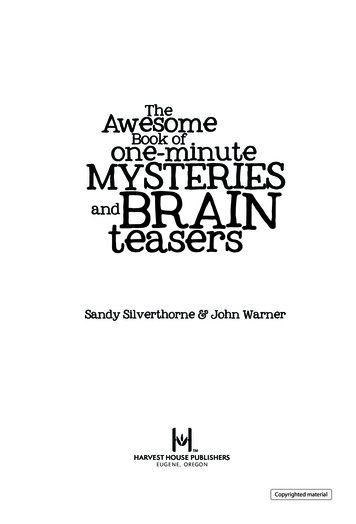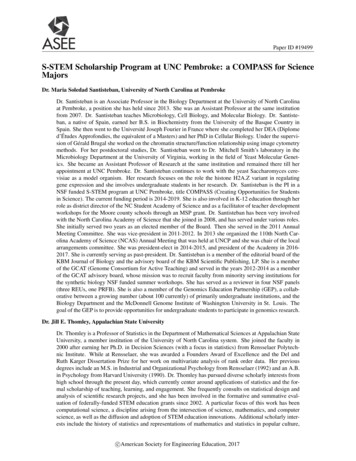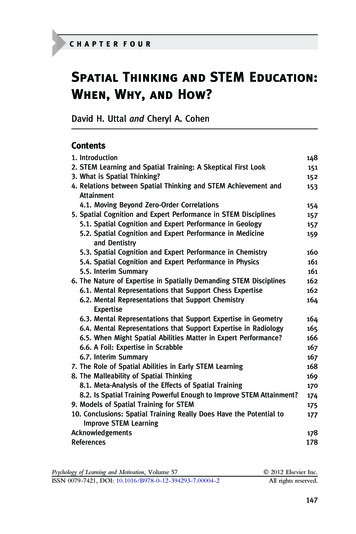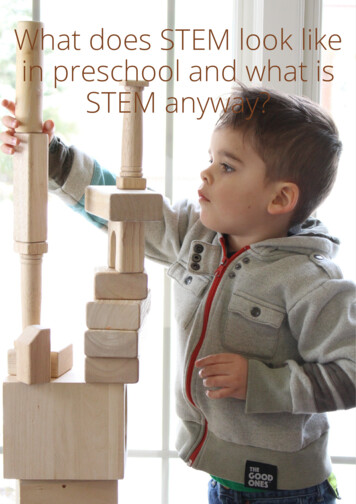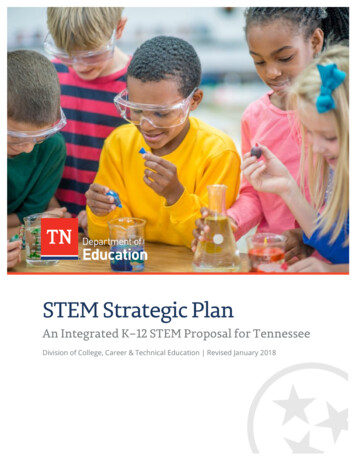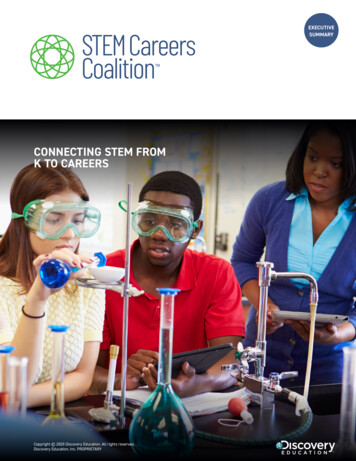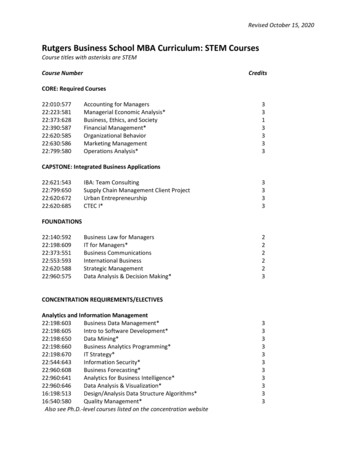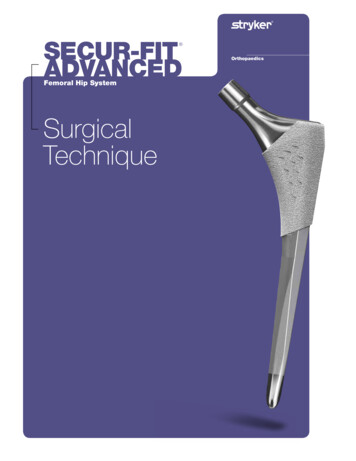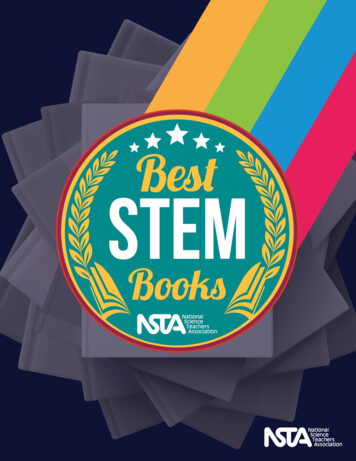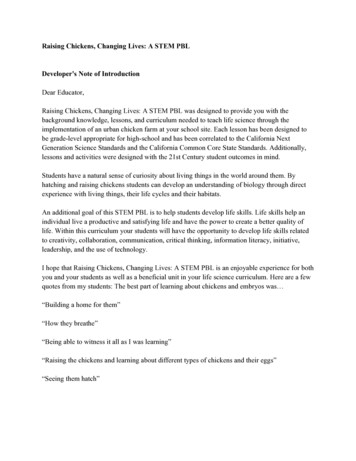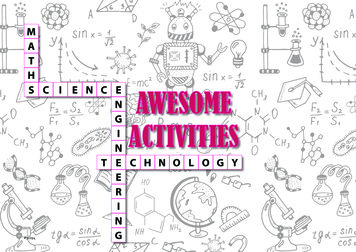
Transcription
MATHS C I E N C ENGINT E C H N O L O G YERING#32094
Associate ProfessorChamindie PunyadeeraDo you need saliva to help you taste your food?What you need: Some kitchen paper towel A scarf or blindfold A glass of water Four samples of dry foods, for example:crackers, dry breakfast cereal, biscuits, pretzels Lemon lolly or chewing gum An adult helper.1. Put on the blindfold and then gently dry your tongue and the inside ofyour mouth with kitchen paper towel to dry up any saliva.2. Ask your helper to pass you a food sample to taste from the dry foods.I have always loved science andresearch because it gives us thechance to think about and solveproblems.Chamindie tests saliva from people to see if theyare sick or healthy.She enjoys helping others and works hard tohelp young girls and women from differentbackgrounds to get interested in science.Is it easy or difficult to chew and eat without saliva?What does the food taste like? Can you guess what it is?3. Taste the other food samples with a dry mouth.Did you guess what they were correctly?4. Ask your helper to pass you a drink of water. Now try tasting each foodsample again with saliva in your mouth.Did you guess what foods you were eating once your mouth was wet?What do your results tell you?Do you need saliva to help you taste your food?5. Now try ‘stimulating’ saliva by sucking on a lemon lolly or chewing gum.How much saliva can you make?Write down what you see.2
Dr Anu ChoudharyConnect thedots to discoverthe invasivespeciesI get to make amazingnew tools to help ourfarmers grow more food.Anu finds new ways of removing unwantedplants from our farms.Not only is Anu good at science but she can alsounderstand four languages—Hindi, English,Punjabi and Bengali. When she was little, shewanted to be an astronaut.New plants, animals and diseases come to Australiafrom around the world unplanned. These species arecalled invasive species when they start breeding andbecome harmful to a habitat's original plants andanimals. Kudzu is a rapid-growing perennial vinethat smothers native vegetation.3
Professor Jonti HornerIn my job, I study the Solarsystem and try to work outwhere we should look for lifebeyond the Earth.As a child, Jonti dreamt of being an astronomer as heloved looking at stars and the night sky.He is always searching for alien worlds. He’s so luckythat he gets to do what he loves doing every single dayof his life! Unfortunately, Jonti is allergic to rosemary—but only gets sick if he eats some and then doesexercise!Our SolarsystemName the planets andcolour them in.Did youknow that astronomershave now foundthousands of planetsorbiting other stars?Maybe, one day, we’llfind a place just likeEarth—with alienslooking back at us,wondering whetherthey’re alone in theuniverse!4
Dr Larisa McLoughlinSTARTI love being able to understandpeople’s brains.Larisa researches children’s brains and whathappens if they are bullied or sad. She is hopingher research will help other people in thefuture.She has always wanted to ‘fix’ people. When shewas a child she wanted to be a surgeon.Your brain communicates with the rest ofyour body using tiny jolts of electricity.Can you trace the signal throughthe brain and down the brain stem?Don’t run into the walls.FINISH5
Dr Bonnie QuigleyCOLOUR ME INI love seeing animals thatare healthy and happyout in the wild.Bonnie studies the germs that make koalassick and tries to make medicines to keep themwell. She has lived and worked in four differentcountries around the world.Her favourite animal is one of Australia’s nativeanimals—the koala.6
Dr Jenni GunterI think science is amazingbecause every dayI learn something new.Jenni studies the way cancer cells make and useenergy and she tries to find new ways to treatsick people. She believes we can use science totry to stop people dying from cancer.Did you know that Jenni likes to hike? She oncewent hiking in the Transylvanian Alps and visitedDracula’s castle.Animals, including humans, are made up of microscopic(tiny) structures called cells. Cells look slightly differentdepending on the different jobs they perform in yourbody, but all cells have certain common parts. Learnabout a few and make this cell colourful.Colour me inRed: I’m the Nucleus, the central round ‘brain‛ ofeach cell and I contain the information that makesyou, you and that makes Jenni, Jenni.Blue: I am the Mitochondrion. I have an oval bodythat contains many folds inside. Me and my siblingsare the ‘power plants‛ of each cell and we make surethat you don’t get tired too fast.Purple: I’m the Golgi complex. I might not look likemuch but I’m a stack of ovals that make sure thateverything a cell produces gets safely wrapped untilit is needed somewhere else.Green: I’m the Endoplasmic reticulum. I’m a lotof folds all throughout the cell and I help to foldproteins into their right shape. Don’t I look like acurly worm?Done? Now make the rest of the cell as colourful as you want.7
Dr Ben AllenGet graphingPlot the numbers onto the graph to show how active the owl is during the day and the night.Join the dots to form a :0018:0019:0020:0021:0022:0023:00TimeOwl e of :0022:0023:00Your :0009:0010:0011:00ActivityCan you plot a graph that shows your own activity levels during the day and night?Make a special mark when you go to bed and when you go to ar more active at dawn and duskDiurnal more active during the dayNocturnal more active at 21:0022:0023:00TimeHe has been bitten by ants, spiders, scorpions,lizards, snakes, birds, rats and cats. Would youbelieve, he has eaten kangaroo, emu, warthogand zebra—all in the name of science! Sincea young child, Ben wanted to be a wildlifescientist, and he grew up to become exactlywhat he wanted to be.10101010109753211ActivityBen studies wild animals in the outback to tryand figure out how to keep them :0009:0010:0011:00TimeIn my job, I get to travel to someamazing places and see someamazing animals.TimeAre owls more active at night or more active during the day? Are they nocturnal animals?Time of day8
Dr Amanda DawsonFind the 15 pieces of rubbishand then colour inIt’s so much fun to learn andtry to figure things out.Amanda is studying how plastic pollution isharmful to the fish and crustaceans like crabsand prawns that live in the ocean.Every day, she is trying to help ocean animals.When she is not working she likes to colour herhair bright colours, and changes the colour everysix months—at the moment it is bright pink!9
Dr Andreas KupzFill in the names of the parts of the bodyand draw a line to where it belongs.BR IE RI love being able to create newknowledge by working with otherscientists who have great ideas.Andreas works on the development of a newvaccine to fight against a disease calledtuberculosis. Tuberculosis is a disease causedby germs that usually affects a person’s lungs,but it can also affect other parts of the body,such as the brain, the kidneys, or the spine. It isa very dangerous disease.He was born in Germany and loves picking lots ofdifferent mushrooms in the forest.L N SE ET T HT Y O DH A TSPINEL V RIN EST NESST M CHK D N YSBL DD R10
Dr Sara HerkeMAKING CONNECTIONSRight now, House A is connected to the electricity and House C is connected to the water. We wantevery house to be connected to both electricity and water. But we don’t want any connections to crossover each other!Can you add connections so that every house is connected to both electricity and water with nocrossing lines? That means each line you draw should not touch any other line.AI love solving challengingproblems and drawing picturesof networks!Sara uses maths and computers to studynetworks. Networks show us how things areconnected to each other.BShe always wanted to be a teacher. Now, shegets to teach maths at university, and sheloves it!DC11
Dr MaryamShirmohammadiI enjoy asking questions,like any good scientist.Maryam studies wood and looks at their cellsand their stiffness. She uses the information tomake stronger wooden products and to use themfor different things such as buildings.She is always interested to know ‘why’ and‘how’. This means she never looks at objects thesame way twice.Add your leaves to this tree—try finger painting oreven using twigs dipped in paint. Add some birdsor animals.When you’re finished, look outside your window.Draw your favourite tree and see if you can findout what type of tree it is.You can also collect leaves from outside andtrace them on the page. What can you see? Art for Kids!Get more art for kid activities at ArtforKidsHub.com/subscribe!12
Dr Jodie RummerI love the underwater world,understanding how things work,and looking after the planet.All of this makes my job perfect.Jodie researches how sharks and other fishesexercise—looking at how they breathe andswim. She is also interested in how they becomestressed with warmer water.She really wants to protect the planet, and hasalways been inspired by television shows aboutthe ocean. Jodie loves to ask questions, and thismakes her a great marine biologist!13
Word SearchDr Shaneel ChandraI am a curious person, andbeing a scientist you ask a lotof questions when you want tomake things better. I love it!Shaneel designs small sensors that can helpdetermine what sickness a person has. Hiswork also includes COVID-19 research. Oddly,although he is a scientist, Shaneel doesn’twatch science fiction shows on television.One of his first experiments as a child was tomix soil and water, and separate rocks. He lovedscience as soon as he could walk.Q X Y K DWSI H S C I E NS A K T J E YP CWPWZ RK R I D J O KWF O E GQ LL S F B N C EQ X D Y L T HV P I K Z E IG A GN P Y ML L YWZMZB S U I E X ZR J E Y Z J IE B T C Y MNP G F O K T UA T UMX I RI HQ P Y S ZR J GU HD KWH P T E X HP V E E L H ZDQO R C L VPWP S X A JE P L T F S YP V E A Y T AQ E Y N Y S HL Y A Y I D H F Y G R O KWG X Q BC E T M E H E A L T H Y Y E X G V FQ L K A Q P Y C J A OW F L O X L DR S G E A G E Y G E Q S P L U S G RL T C A S F X U S T R E N B L X J UC U R I O S I T Y I S H J E U X S KX P E R I M E N T S HQ S I G V V AR B G T V N P T B E E S R NMO I ME D I S E A S E U T L R E G V K A US M T T U V C A Y U P D Y I RMNGS T I V X V U S R G F L Y F Q L S EE O P S DWR O C S U T S I D SWEB L L Y T J E L MW L J E G Z R E XY E O V H R S V J C Z N NG X E R CD E RW I H Y E E HD J S F X J S II M K Q K NWM Q MM Y O G Y N R TS K T Y Z P G F R E O R R P WM T IC F L I V C E E R N S Q S Y C P K NOWO A C S A U I N R P H MO Y U GV Z U KMH K C U R I O S I T Y R QE OM J D Y G L S A N T C GO R H VR QU E S T I ON S ND P C U L L YY HMR J F E P T A UMO K UGG VI S J J J B D Z Z K D I M E NDNHD P N J I S I C K N E S S R E Y K D?Which word killed thecat? It’s in here twice ANSWERSDISCOVERYCHEMISTRYDISEASECOMPUTERS experimentsEXCITINGproblem ULMENDPEOPLEPROBLEM lpful14
Dr Linlin MaExperiment: Lava LampMaterials: A clean plastic bottle, try to use one withsmooth sides water Vegetable oil (or you could use baby oil) Fizzing tablets such as Alka Seltzer Food colouringInstructions:My job is so interesting andchallenging, and it is good to tryto help others.1. Fill the bottle up about one quarter withwater.2. Pour the vegetable or baby oil in the bottleuntil is almost full. You may want to use ameasuring cup with a spout or a funnel. Waita couple of minutes for the oil and water toseparate.3. Add a few drops of your food colouring.Watch as the colour sinks through the oil.Did your drops of colour mix with the waterimmediately or float in between for a fewminutes?4. Break your fizzy tablet in half and drop part ofit into the bottle. Get ready here come thebubbly blobs!5. You can even get a torch, turn off the lightsand drop in another half tablet. This timeshine the torch through the lava lamp whilethe blobs are bubbling!Linlin tries to understand how some braindiseases happen and help doctors find bettertreatments for them.As a child, she loved one of her primary schoolteachers so much that she wanted to become ateacher too. She now teaches at university.She has a 10-year-old daughter and they makeup riddles and puzzles. Guess who wins more?15
Dr Robert ClemensI love learning about wildlife,spending time in the outdoorsand working to protect theenvironment.Robert takes large groups of volunteers to learnabout Powerful Owls.When he was younger, he spent 20 yearsclimbing mountains throughout the world, andbefore that he wanted to be a pilot!Birds come in all shapes and sizes. The largest bird is the ostrich at2.7 metres tall and the smallest bird is the hummingbird atfive centimetres tall.Did you know anyone, young or old, can be a citizen scientist?Citizen scientists are volunteers who help scientists research.16
Dr Rob CaponDid you know?102 cane toads were released in Queensland in 1935 to control thecane beetle. In less than 85 years, the cane toad population hasmultiplied to epidemic proportions. Now, some scientistsestimate that there are more than 200 million cane toadshopping around our continent, wreaking havoc onour ecosystem and expanding across northernAustralia at a rate of 50 km every year.I like my job because I get tomake exciting new discoveriesabout how nature works, andto use this to solve importantproblems.Rob uses science to catch millions of poisonouscane toad tadpoles, to protect the environment,native animals and pets.In his spare time he likes to do quickcrosswords!JOIN THE DOTS AND17
Dr Stephanie SchoeppeActivity: 10 for 10Come up with 10 outdoor activities during which you can pick up‘10 pieces of plastic litterʼ when you are out in the local area,park or beach.Hint: there’s no right answer, but think about games and activities you doevery day like walking to school or taking the dog to the park.1I love doing research and wantto teach children to have anactive healthy lifestyle.Stephanie helps families to become morephysically active by giving children and theirparents physical activity trackers and smartphone apps to track and increase their stepsand active minutes. She wants us all to be moreactive and have fun with each other.Stephanie tries to protect the environment bythinking about what she eats, usesand throws out.234567891018
Julia LackenbyComplete the crosswordAcross1. What to give someone who is sick6. Where scientists work to run experiments8. What scientists do10. Another word for ‘see’ or what you do whenwatching an experimentNamComplete the crossword puzzle belowI love my job because every day is anew adventure. I get to ask questionsand then design and run experimentsto find the answer.Julia is working on a COVID-19 vaccine that willteach our immune system what the virus lookslike so if our body sees it, it can fight it off beforeit can make us sick. She originally wanted to bea doctor, but changed her mind when she wasdoing work experience in a hospital and foundthat she wanted to follow the samples to the labto run tests. Now she works in a laboratory tostop people from getting sick.ANSWERSAcross1. medicine6. laboratory8. research10. observeAcross123Down2. When scientists find something new3. Something you might find in a lab4. The results of an experiment go into a special document5. Something to give you to prevent you getting a disease7. STEM is short for , technology, engineeringand maths9. The opposite of healthy534678910You can help stop the spread of viruses like COVID-19 by:1. your hands with soap and water, then using sanitiser.2. Trying not to your eyes, nose and mouth (this can be really hard).3. Staying if you are sick.Down2. discovery3. test tube4. report5. vaccine7. science9. sickwashing hand touch home1. What to give someone who is sick6. Where scientists work to run experimentsCreated using the Crossword MakerDown192. When scientists find something new3. Something you might find in a lab
4PLANETS (L–R): Mercury, Venus, Earth,Mars, Jupiter, Saturn, Uranus, Neptune.10There are various solutions this is only 835Word2Search414Time of day5Q X Y K DWSI H S C I E NS A K T J E YP CWPWZ RK R I D J O KWF O E GQ LL S F B N C EQ X D Y L T HV P I K Z E IG A GN P Y ML L YWZMZB S U I E X ZR J E Y Z J IE B T C Y MNP G F O K T UA T UMX I RI HQ P Y S ZR J GU HD KWH P T E X HP V E E L H ZDQO R C L VPWP S X A JE P L T F S YP V E A Y T AQ E Y N Y S H233L Y A Y I D H F Y G R O KWG X Q BC E T M E H E A L T H Y Y E X G V FQ L K A Q P Y C J A OW F L O X L DR S G E A G E Y G E Q S P L U S G RL T C A S F X U S T R E N B L X J UC U R I O S I T Y I S H J E U X S KX P E R I M E N T S HQ S I G V V AR B G T V N P T B E E S R NMO I ME D I S E A S E U T L R E G V K A USM T T U V C A Y U P D Y I RMNGS T I V X V U S R G F L Y F Q L S EE O P S DWR O C S U T S I D SWEB L L Y T J E L MW L J E G Z R E XY E O V H R S V J C Z N NG X E R CD E RW I H Y E E HD J S F X J S II M K Q K NWM Q MM Y O G Y N R TS K T Y Z P G F R E O R R P WM T IC F L I V C E E R N S Q S Y C P K NOWO A C S A U I N R P H MO Y U GV Z U KMH K C U R I O S I T Y R QE OM J D Y G L S A N T C GO R H VR QU E S T I ON S ND P C U L L YY HMR J F E P T A UMO K UGG VI S J J J B D Z Z K D I M E NDN HD P N J I S I C K N E S S R E Y K Dkilled the :0007:0008:0009:0010:0011:00Owl activityActivity8Time134CURIOSITY4problem swers
Queensland is home to lots of people who use allsorts of amazing science, technology, engineeringand mathematics (STEM) in their jobs.A big thank you to those who have contributedactivities to this book and for sharing their love oftheir work.We hope this activity book inspires youngQueenslanders and provides information about thegreat work happening in Queensland and the rangeof careers in STEM.If you’re a teacher, parent, scientist or researcher,you may like to read our Engaging Queenslandersin Science strategy. This strategy looks to involve allQueenslanders in science—at school, at events andat home. It is available at www.chiefscientist.qld.gov.au.Special acknowledgement to Professor KathyAndrews from That’s Rad! Science for the conceptidea.For more fun activities, visit theOffice of the Queensland ChiefScientist websitewww.chiefscientist.qld.gov.au.#32094 0820Hope you enjoyour awesomeactivities.
2. Ask your helper to pass you a food sample to taste from the dry foods. Is it easy or difficult to chew and eat without saliva? What does the food taste like? Can you guess what it is? 3. Taste the other food samples with a dry mouth. Did you guess what they were correctly? 4. Ask your helper to pass you a drink of water. Now try tasting each .
